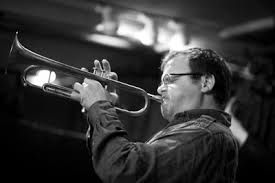Solitaire – Ryan Kisor
This song shows a more melodic, subdued side of Ryan Kisor than usual, while still being subtly angular. The melody has a wide range, covering 2 1/2 octaves.
- Recording: Ryan Kisor - This Is Ryan
- Recorded on: March 8, 2005
- Label: Video Arts Music (VACM 1266)
- Concert Key: A minor
- Vocal Range: , to
- Style: 3/4 swing (medium)
- Trumpet - Ryan Kisor
- Tenor Sax - Grant Stewart
- Piano - Peter Zak
- Bass - John Webber
- Drums - Jason Brown
0:00
0:00
Buy MP3
Video
- Description
- Historical Notes
- Solos
- Piano Corner
- Bass Corner
- Drum Corner
- Guitar Corner
- Inside & Beyond
- Minus You
Like The Dream, this song shows a different side of Ryan Kisor's composing than his usual uptempo challenges. It's relatively simple and quite melodic, though it retains some of Kisor's signature angularity by virtue of its pentatonic theme material. The 48-measure form is harmonically ABA in 16-measure sections, though the melody is slightly different on the last 16 measures from the first 16; the lead sheet divides the form in eight-measure sections. There is really one type of harmonic progression throughout, which first appears as a diatonic descent of four chords from Am7 to Dm7, skipping G7; in fact this song has no dominant chords. This sequence appears four times, followed by the same thing up a major third, twice, in the C section (first half of the "bridge" if the form is treated as a longer ABA). The D section has a variation of the sequence starting on Bm7, with A♭maj7 at the end to plane back to Am7 for the last 16 measures.
The melody also develops just a few ideas throughout the form; the A and E sections have the same melody, and the F section melody is a transposition of the beginning of the C section. Though more subdued than many Kisor compositions, this song is still a bit of a challenge because of the wide range of the melody; the line from the fifth measure of C to the fourth measure of D rises and falls over a range of two octaves and a 3rd. Our E♭ lead sheet has a few passages down an octave where it would be convenient to switch octaves.
There is an intro with a piano melody, again related to the head but over alternating G and F major chords. It's notated in the lead sheet. The coda tags the last eight measures of the head one more time.
The melody also develops just a few ideas throughout the form; the A and E sections have the same melody, and the F section melody is a transposition of the beginning of the C section. Though more subdued than many Kisor compositions, this song is still a bit of a challenge because of the wide range of the melody; the line from the fifth measure of C to the fourth measure of D rises and falls over a range of two octaves and a 3rd. Our E♭ lead sheet has a few passages down an octave where it would be convenient to switch octaves.
There is an intro with a piano melody, again related to the head but over alternating G and F major chords. It's notated in the lead sheet. The coda tags the last eight measures of the head one more time.
Peter Zak has been the pianist on every Ryan Kisor-led album with piano since 1998's "The Usual Suspects." The same almost goes for John Webber on bass, with the exception of the piano-less "Power Source" (1999) with James Genus, and "Live at Smalls" (2008) with Carlos Henriquez. Ten days after the "This Is Ryan" session, Webber played on Eric Alexander's album "Sunday In New York." Also in March 2008, Grant Stewart recorded his first Video Arts album as a leader, "Tenor And Soul."
Related Songs
Email Send Solitaire to a friend
Send this page to a friend via email. Add your name or email in the first field. In the second, add one or more email addresses, separated by a comma.

Ryan Kisor
born on April 12, 1973
Perhaps best known for his work with the Jazz at Lincoln Center Orchestra, Ryan Kisor is an accomplished trumpeter and one of the rising names on the jazz scene. Firmly rooted in the post-bop tradition, Ryan has obviously done a lot of listening to giants like Clifford Brown and Booker Little and Woody Shaw. Of course, he's also been influenced by contemporary mentors including Clark Terry and Wynton Marsalis, both masters of the art of great trumpet playing. Read more...
There was a problem.
...

